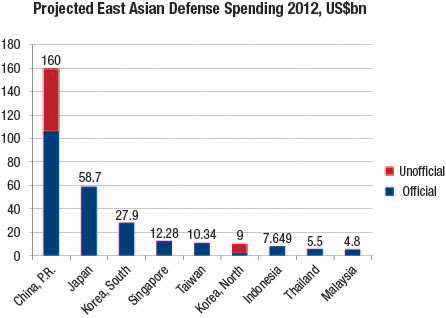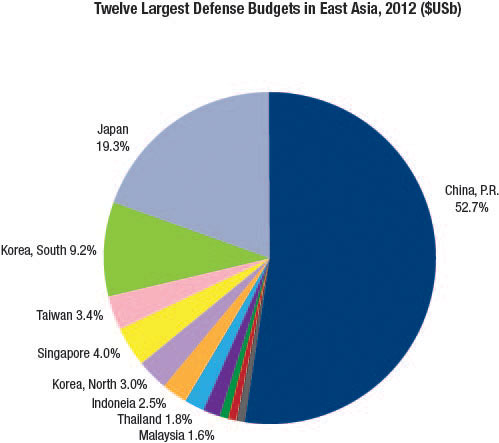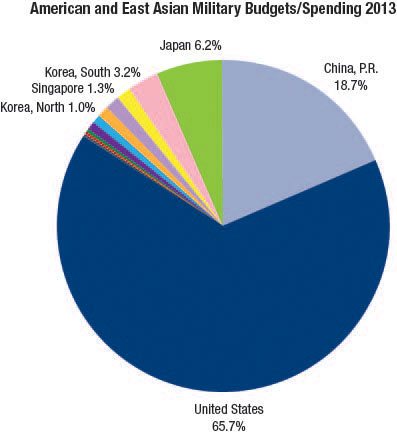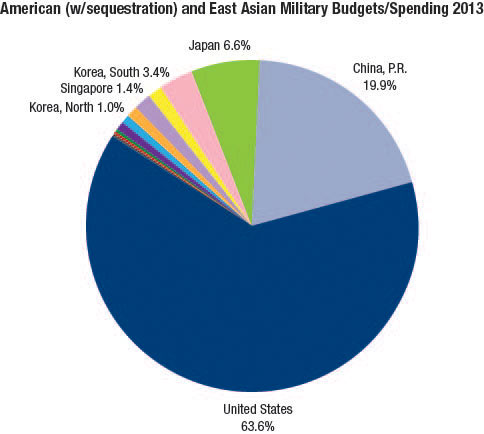PART III: The Sequestration Story in East Asia
Editor’s Note: This article appeared in a five-part series for
Time Magazine’s Battleland blog
.
A version of the article was presented at a private event at Brookings organized by the
Center for Northeast Asian Policy Studies
and the
21st Century Defense Initiative
. The article is also
available in Korean
.
The U.S. may have global power and responsibilities, but in recent years, a strategic shift has occurred. China’s military has risen in conjunction with its driving economy, which has prompted a refocus on Asia and a “pivot” or “rebalance” in American grand strategy. Thus, while we explored in previous sections the drivers of sequestration and what it might do to the U.S. defense budget in comparison to world military spending, that would miss a major part of the story. One should also put U.S. military spending not just in a global context but a regional one.
Within Asia, China is a dominant defense spender, both in its official budget and its more realistic unofficial budget. North Korea, which we’ll look at in more detail in the next part, equally has a disconnect between its official budget of $1 billion and the more likely estimates of $9 billion. [14]
However, here again, the numbers take on a far different interpretation when you include the true Asian superpower, the United States, in the context.
If sequestration were to occur, the U.S. slice of the pie gets smaller, but would still be a dominant slice, even more so if one includes its allies in the weighting.
Of course, the U.S. has global responsibilities, and so these figures should not be taken as the end of the story. Akin to the German naval position versus the British prior to World War I, a rising regional power like China might present a larger threat than any straight comparison of their relative numbers. A global power like the British back then or the U.S. today can be spread too thin, while the regional power’s resources are all focused (so the British during this period used variations on the “two power standard” as their guide to naval force size, ensuring a fleet larger than the two next powers combined). Of course, in turn, the global power can still bring these other resources to bear in regional scenarios whenever the situation grows important, and that local power is also counterbalanced by the other allies within the region, who see its growth as a threat.
Military spending as compared to GDP shows similar weights. Other than North Korea, which has the dark combination of being a garrison state with a withered economy, the U.S. percentages still rank high regardless of the scenario. Even in the worst scenario of sequestration, the U.S. is still at 3.45% of GDP, a full point higher than China at 2.36% of its smaller but rapidly growing economy.
| «Read Part 2: Context Matters: Sequestration and America’s Military Spending Compared to the World | Read Part 4: Sequestration and the Korea Peninsula» |
[14] “The Conventional Military Balance on the Korean Peninsula,” International Institute for Strategic Studies, 2012, http://www.iiss.org/publications/strategic-dossiers/north-korean-dossier/north-koreas-weapons-programmes-a-net-asses/the-conventional-military-balance-on-the-kore/. Based on estimates of 25-33% of total GDP, which is currently projected at approximately $40 billion.
[15] Sources for figures used in chart include: “OMB Report Pursuant to the Sequestration Transparency Act of 2012 (P. L. 112–155),” Office of Management and Budget, September 14, 2012, http://images.politico.com/global/2012/09/120914_omb_report_sequestration.html.
Keith B. Richburg, “China military spending to top $100 billion in 2012, alarming neighbors,” The Washington Post, March 4, 2012, http://www.washingtonpost.com/world/china-military-spending-to-top-100-billion-this-year/2012/03/04/gIQAJRnypR_story.html.
“China military budget tops $100bn,” BBC News, March 4, 2012, http://www.bbc.co.uk/news/world-asia-china-17249476.
Paul Kallender-Umezu, “Japan Strives to Overcome Defense Industrial Base ‘Crisis’,” DefenseNews, June 24, 2012. http://www.defensenews.com/article/20120624/DEFREG03/306240003/Japan-Strives-Overcome-Defense-Industrial-Base-8216-Crisis-8217-.
“Defence budget (Malaysia), Defence budget,” Jane’s Sentinel Security Assessment, July 3, 2012, http://articles.janes.com/articles/Janes-Sentinel-Security-Assessment-Southeast-Asia/Defence-budget-Malaysia.html
“The Conventional Military Balance on the Korean Peninsula,” Institute for International Strategic Studies,” 2012, http://www.iiss.org/publications/strategic-dossiers/north-korean-dossier/north-koreas-weapons-programmes-a-net-asses/the-conventional-military-balance-on-the-kore/.
“Taiwan Budget 2012,” Finance: Maps of World, February 10, 2012, http://finance.mapsofworld.com/budget/taiwan/.
“Singapore raises defense spending by 4.3%,” AsiaOne, February 17, 2012, http://www.asiaone.com/Business/News/Story/A1Story20120217-328632.html.
“S Korean defense budget sees 5.6% increase in 2012,” September 27, 2011, http://news.xinhuanet.com/english2010/world/2011-09/27/c_131163128.htm
“Vietnam Announces a 2012 Defence Budget of VND70 trillion (3.3 billion USD),” Defence Studies, November 23, 2011, http://defense-studies.blogspot.com/2011/11/vietnam-announces-2012-defence-budget.html.
Daisuke Furuta, “Myanmar slashes military spending,” The Asahi Shimbun, February 7, 2012, http://ajw.asahi.com/article/asia/south_east_asia/AJ201202070025.
“Indonesia and Philippines to Increase Spending on Defense in 2013,” Defense Studies, July 25, 2012, http://defense-studies.blogspot.com/2012/07/indonesia-and-philippines-to-increase.html
“Long Term Implications of the 2013 Future Years Defense Program,” Congressional Budget Office, July 2012, http://www.cbo.gov/sites/default/files/cbofiles/attachments/07-11-12-FYDP_forPosting_0.pdf.
[16] Ibid.
[17] Ibid.
[18] Ibid.
[19] Ibid.








Commentary
Separating Sequestration Facts from Fiction: Defense Sequestration and What It Would Do for American Military Power, Asia, and the Flashpoint of Korea
September 23, 2012